Ex Health Canada Scientist and whistleblower Dr. Shiv Chopra had stated that the war on GMO, along with that of vaccines, might be won or lost in India. Following the same view, Teresa Lynn, a mother and a grandmother born and raised in British Columbia, sends a letter to the Government of India, requesting it to reject the newly proposed BRAI bill.
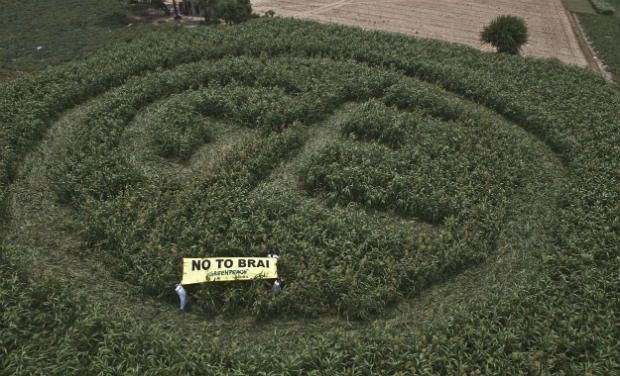
- Crop circle in protest against BRAI bill
Bt. Cotton enters India through the backdoor
Bt.Cotton entered India through the back door. By the time the Government had the item on its table, to approve of disapprove, the crop was already all over the place. Hence the Govt approved it, belatedly. In fact, it was suggested that the Govt might as well approve it, since it is already present everywhere.
The story of the cotton farming in India is shaping up to be an unmitigated disaster as well as a humanitarian crisis of epic proportions, with over a quarter million farmer suicides recorded in the past decade, mostly in the cotton belt, and driven by a debt spiral and economic collapse of the small farmers.
Bt. Brinjal is halted
IN the background of that episode, came the issue of bt.Brinjal (Bt.Eggplant). Brinjal (eggplant) originated in India. India enjoys the highest diversity of the plant, more than six thousand varieties of it. IN some areas, every twenty miles presents a different kind of Brinjal, evolved and hybridized over long experimentation to suit that soil, air, temperature, rainfall and humidity.
Monsanto and its Indian partner attempted to introduce the transgenic Bt.Brinjal in 2010, and the food security activists, farmers unions, sustainable agriculture promoters, and concerned citizens started a mega-mvoement to protest introduction of Bt. Brinjal. The movement got so big that the environment minister went into a fact finding spree and a public discussion with scientists and experts – to arrive at the decision that Bt. Brinjal posed an unacceptable risk to India’s food security and biodiversity, and blocked its introduction by a moratorium.
The citizens of India had won the day.
Provincial versus Federal Jurisdiction
While official introduction of GMO was halted, what remained was field trials of some GMO. Here the ministry of Agriculture maintained that field trials cannot be stopped. Needless to say, the Ministry of Agriculture, just like the Ministry of Science and Technology, is pushing for GMO, and show scant concern for either biosafety or food security.
However, when field tests were being planned, seven provincial Governments complained to the centre, that such field tests were planned in their territory without consulting with the provincial Government, and this was resisted by the state Government.
Subsequent to such pressure, the Federal Government passed a directive that the Provincial Governments should be consulted, and their approval obtained, before initiating field trials of GMO. Seven provinces did not agree to field trials. These are: Kerala, Karnataka, Chhattisgarh, Madhya Pradesh, Odisha, Bihar and West Bengal, basically provinces of the South, centre and east of India. These are heavy in agriculture. As a result, even field trials became restricted. Future of GMO in India got into the doldrums.
Cartagena Protocol
The Cartagena Protocol on Biosafety to the Convention on Biological Diversity is an international agreement which aims to ensure the safe handling, transport and use of living modified organisms (LMOs) resulting from modern biotechnology that may have adverse effects on biological diversity, taking also into account risks to human health. It was adopted on 29 January 2000 and entered into force on 11 September 2003.
This Protocol apply to the transboundary movement, transit, handling and use of all living modified organisms that may have adverse effects on the conservation and sustainable use of biological diversity, taking also into account risks to human health. It calls for setting up risk management systems to ensure transgenic organisms imported into the country are going to be safe.
India is a signatory since 2003. Among many other provisions within the Protocol, one is exampled here – Article 23, which deals with public awareness and participation in Government decision making with regard to GMO.
ARTICLE 23 – PUBLIC AWARENESS AND PARTICIPATION
1. The Parties shall:
(a) Promote and facilitate public awareness, education and participation concerning the safe transfer, handling and use of living modified organisms in relation to the conservation and sustainable use of biological diversity, taking also into account risks to human health. In doing so, the Parties shall cooperate, as appropriate, with other States and international bodies;
(b) Endeavour to ensure that public awareness and education encompass access to information on living modified organisms identified in accordance with this Protocol that may be imported.
2. The Parties shall, in accordance with their respective laws and regulations, consult the public in the decision-making process regarding living modified organisms and shall make the results of such decisions available to the public, while respecting confidential information in accordance with Article 21.
3. Each Party shall endeavour to inform its public about the means of public access to the Biosafety Clearing-House.
BRAI bill
The GMO promoters, which included the big money, corporate world, finance, banking and almost the entire political hierarchy of Delhi, got into higher gear to find ways and means to introduce GMO patented by foreign corporations.
Thus, the BRAI (Biotechnology Regulatory Authority of India) bill came to be written – and awaits passage in Parliament. The details of this bill is regressive and is already being called India’s own Monsanto Protection Act. It tries to create a single window clearing house for approval of GMO, placing the regulatory (risk assessment) and the promotion of GMO under the same ministry (of Science and Technology) – a clear and deliberately created conflict of Interest.
The Government announced the bill on June 10, giving the public one month (till July 10) to respond to it.
Meanwhile, the Indian civil society has learned, that to ward off GMO in India, the public needs to exert sustained strong pressure to counter the GMO lobby, and be ever vigilant against it.
And thus, the civil society and the activist groups are gearing up again to counter this threat.
Public Response
There are two motions already unrolled by various groups. The first is to write a rebuttal to the Government, asking them to scrap the BRAI bill.
The second is a petition to allow more than one month, for the public awareness and participation. I wrote a letter to the Govt. of India, as did Teresa Lynn of British Columbia, Canada. My letter is copied here. Teresa’s letter is presented as an audio podcast at the bottom of this blog, and also in iTunes.
My letter to the Govt of India
I have sent my letter to the Govt. Of India by email, as below:
———————————————————————————
Mr. Alok Chatterjee, Director, Rajya Sabha Secretariat , Room # 005, Ground Floor, Parliament House Annexe, New Delhi 110001, India
Telephone +91-11-2303 4597, Fax +91-11-2301 5585,
Email : rsc-st@sansad.nic.in
Subject : Response to the proposed BRAI bill
Dear sir,
I am a non resident Indian citizen residing in Canada. I write this letter in response to the Governments invitation for feedback from the public regarding the Biotechnology Regulatory Authority of India act, published by the Govt. Of India on the 10th of June, 2013.
I believe this bill is regressive instead of progressive towards safety, and if implemented is going to be more harmful for the Indian public as well as its environment, than if the bill did not exist. Therefore, I believe this bill should be rejected. The reasons for the same are briefly listed below.
1. Wrong science
The biotechnology behind the creation of GMO is 70 years old, backdated, and proven to be faulty. The technology is based on the assumption that one gene in a plant genome codes for one protein and nothing else. Therefore, if that gene can be exchanged with another gene from another organism, then the implanted gene would only do what it was doing in its original host organism, and nothing more. This has proven to be wrong in the last ten years, ever since the human genome project was completed in year 2002. Everybody was expecting human genome to have over 100,000 genes, because it was known that the human body requires and produces, over 100,000 proteins. However, the genome project proved that humans have only around 20,000 genes and a lot of unrecognized “junk DNA”. Now it is understood that the junk DNA is not junk at all, but some sort of a control mechanism, the brain, of the DNA ecosystem, that tells individual genes what protein to produce and what not to, depending on situation. In other words, a gene first of all produces a lot more than a single protein, and secondly, what it may or may not produce is controlled often not just by the gene alone, but the entire genome ecosystem or control mechanism of the organism. Subsequently, independent studies have indicated that there are a lot of collateral DNA damage and unintended consequences in GMO crops, and that proteins that were not intended may also be produced as a side effect. A lot of proteins are very toxic, such as snake or scorpion venom. Independent study seems to indicate severe adverse effect on animals exposed either to GM crop or to accompanying GM herbicide. Also, detrimental side effects of consuming such crops can lead to all kinds of problems over the long term, sometimes evident after decades, or even in the next generation of children.
Therefore, precautionary principle calls for independent and rigorous test of the products for ill effects on humans and the environment, and not depend on test results provided by the patent holding biotech industry itself, which has a vested interest to see its product approved.
2. Wrong Ministry
The testing of bio-safety should be under the ministry of environment, and away from the ministry of Science and Technology. This product poses a serious and possibly irreversible threat to India’s biodiversity. The ministry of science has a mandate, to promote GMO without putting in place any mechanism to independently test GMO by labs and institutions that cannot be influenced by the ministry, or the industry.
3. Wrong examples : Canada’s example is what India should not follow
Here in Canada, the cross pollinated contamination of GM canola is so complete across the entire country that it is now virtually impossible to get organic, non-contaminated canola seed for a farmer. As the organic product becomes difficult to produce, and the regulations tend to promote GM crops and make it economically harder for farmers to produce traditional variety, the number of small farmers are decreasing, and agriculture is taken up by large agri-corporations that spray the fields with pesticides from the air, and raise mechanized GM crop, large cutting labor cost, and enjoying a temporary economic benefit of economics of scale. But in due course, insects and weeds develop resistance to the GM crops, thence requiring several times more pesticide, or stronger pesticide, all of which are patented and comes at a high cost.
By losing the organic Canola, Canada is lost a huge export market to the EU, who will not touch GM canola.
Today, less than 1 percent of Canadian population is engaged in farming. Average age of Canadian farmer is above 60. Half of the farmers will retire within the next five years. 75% of the farmers have no succession plan. Farmers in Canada is going extinct, to be replaced by robotic mechanized, industrial scale, chemical dependent, unnatural GM harvest, which is heading for a disaster, both for health and for environment.
Grassroots resistance is rising across the nation and may become a political issue in the coming election.
India cannot afford to make its farmers extinct and need not follow the Canadian, or Australian or the US trend. Natural, non GM farming is labor intensive and can employ a huge population – which has proven to be good for india. India does not need to change that model and push farmers out of farming.
4. Wrong security: Food security sacrificed
India should not hand over its food security to patent held in foreign corporations and take away the farmers rights to replant their seeds, like they have done for the past ten thousand years. India does not need to mortgage its food security to corporations.
This bill is dangerous for food security of a nation of over a billion people, and plays with the livelihood of hundreds of millions of farmers.
5. Wrong ecology : Loss of biodiversity
India is enormously rich in its biodiversity, all of it either naturally evolved or is a result of collective effort of generations of farmers across the land and across time. This rich heritage will prove useful and key for survival. GM crops promote mono-culture, where thousands of kinds of a plant go extinct and only one patented kind remains. This is a recipe for disaster. Climate change, loss of water resource, excess pesticidal toxins in the soil, extinction of beneficial insects bees and micro-organisms are all going to cumulatively make the GM crop unsustainable and India faces a crisis of a kind it may overcome only by using the heirloom seeds that have been specifically raised to deal with difficult conditions such as draught, flood, or incursion of saline or brackish water due sea level rise etc.
India had over 100,000 strains of rice a few decades ago. Today, it hardly has 2,000 strains and those too are disappearing rapidly, thanks to excessive dependence on an unsustainable agricultural model ever since the false green revolution. This is a crisis that is irreversible. Those special strains were generated through hit and trial on special conditions over millennia of experimentation and cannot be reproduced in a hurry, and certainly not by the biotech industry.
6. Wrong policy : Public discussion and access to information
By being signatory to the Cartagena Protocol, India has agreed to put in place various safeguards against inadvertent damage to the nations bio-safety through introduction of GMO. This included engaging in public debate and placing all relevant details in the public domain, so that independent verification can be done by people and institutions that do not have a conflict of interest. This bill attempts to bypass the public discourse as well as curtail access of bio-safety and other information because of proprietary confidential information of the patent holder. Safety information for public should always take precedence over proprietary intellectual property rights. If the biotech firm is not willing to divulge all details of the product and its safety tests for public scrutiny, then the products should be automatically considered unsafe and unsuitable.
7. Wrong characteristics : GMO do not increase yield
Despite being touted as the solution to population increase, GMO are not produced for higher yield. GMO are specifically produced so that their accompanying pesticide can be applied in greater quantity, thus increasing sale of the patented pesticide and herbicide. Besides, hunger is a function of poverty and not of availability of food. India itself is a good example of producing enough food but making to expensive for the poor man, thus allowing hunger and malnourishment to persist. GMO only accelerates the same – food will get most expensive, and the farmers get poorer and more debt ridden.
8. Wrong power : Concentration of authority in the hand of the Union Government
The control of bio-safety needs to be de-politicized and de-centralized. But the bill attempts to do the opposite and concentrates power within the science and technology ministry, so the regulators and the promoters of GMO are under the same roof and in the same bed – a serious conflict of interest and unacceptably dangerous concentration of power.
9. Wrong priority : GM crops being promoted for plants that do not need to be changed.
Plants that have no problem with pesticide or production and originated in the region and has the maximum diversity, do not need to be replaced by GMO. There has to be first of all an analysis of if the plant at all needs to be improved. Such “NO need evaluation” should be mandatory. Bt. Brinjal example highlights this case amply.
10. Wrong risk management
The bill proposes no risk management mechanism.
It is for all these reasons that I strongly urge the Government to reject his bill outright.
If one needs to create a bill for safety against GMO, suggest follow Norways “Act of 2nd April 1993 No. 38 Relating to the Production and Use of Genetically Modified Organisms, etc. (Gene Technology Act)”. It provides a good example of ensuring public and environmental safety with relation to GMO.
Thanking you
(name and address added)
——————————————–
 Teresa Lynn‘s letter is included here as a podcast, linked at the bottom of this blog page. A lady born and raised in British Columbia, she believes, like Dr. Shiv Chopra mentioned, that this is a global struggle against GMO and India is a key battlefield where the war might be won or lost. And so, we lent her time, and her voice, in joining countless others in requesting the Government of India not to abandon its citizens, its food security, its ecology and its biodiversity, in favor of corporate profit. You can listen to this 4.5 minute podcast by clicking the triangular play button at the bottom of this page. You can also find it in iTunes, by searching for podcasts under my name – Tony Mitra. The logo of the iTunes podcast is shown at at left.
Teresa Lynn‘s letter is included here as a podcast, linked at the bottom of this blog page. A lady born and raised in British Columbia, she believes, like Dr. Shiv Chopra mentioned, that this is a global struggle against GMO and India is a key battlefield where the war might be won or lost. And so, we lent her time, and her voice, in joining countless others in requesting the Government of India not to abandon its citizens, its food security, its ecology and its biodiversity, in favor of corporate profit. You can listen to this 4.5 minute podcast by clicking the triangular play button at the bottom of this page. You can also find it in iTunes, by searching for podcasts under my name – Tony Mitra. The logo of the iTunes podcast is shown at at left.
Reference links:





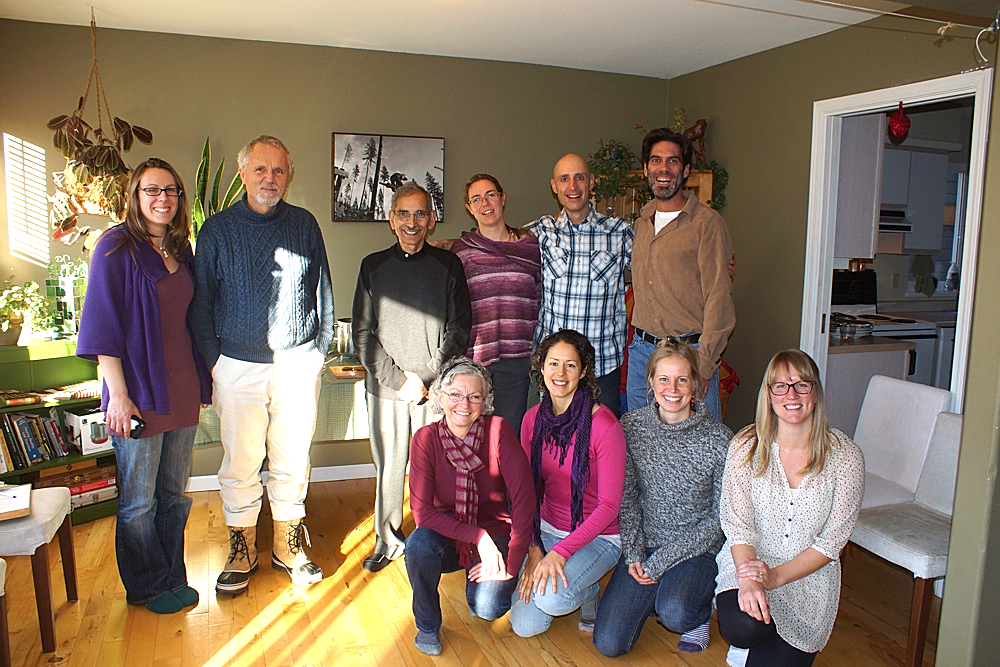
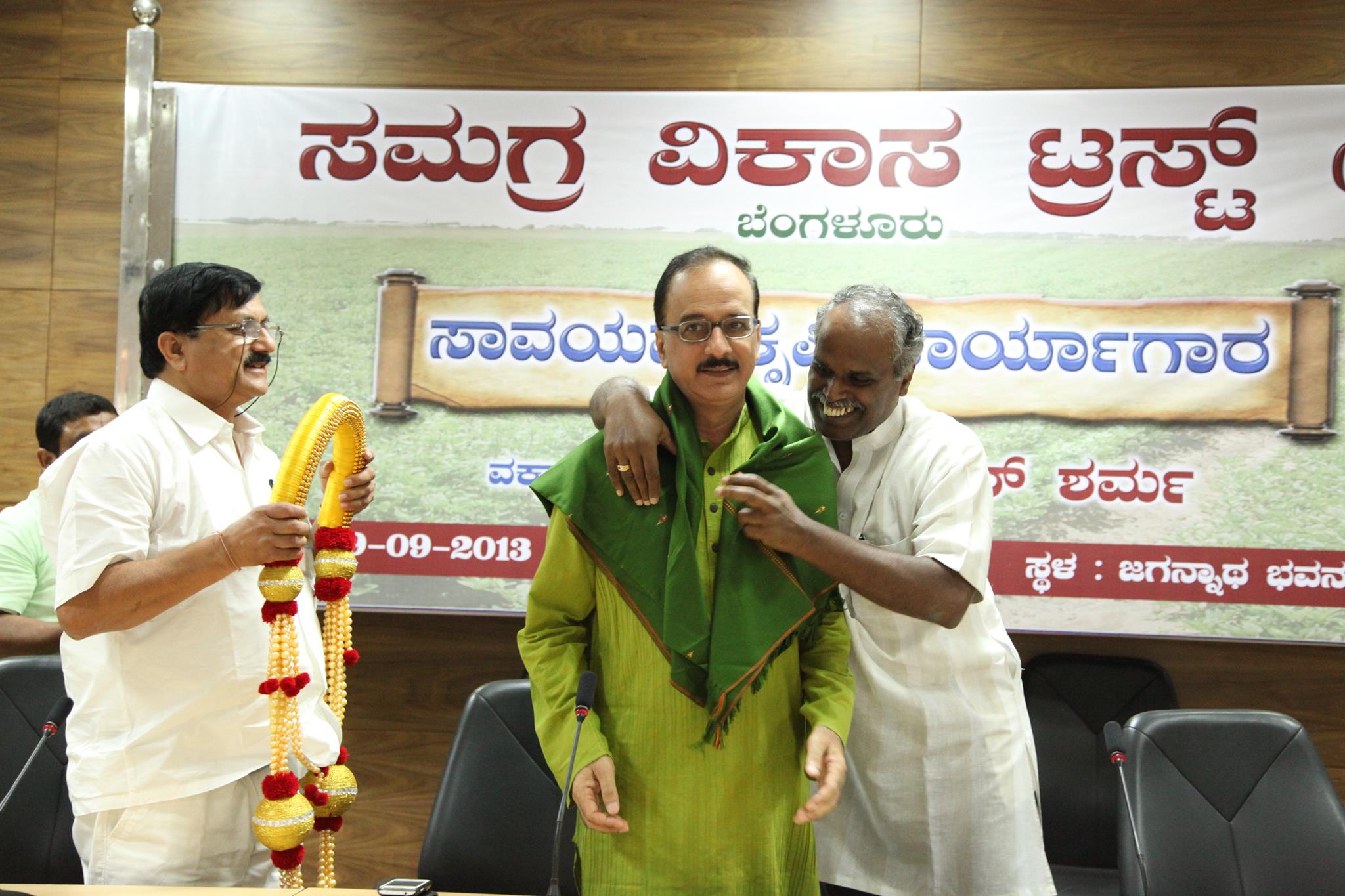




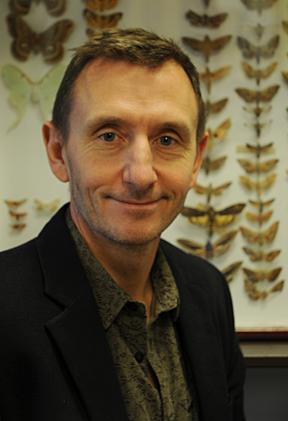


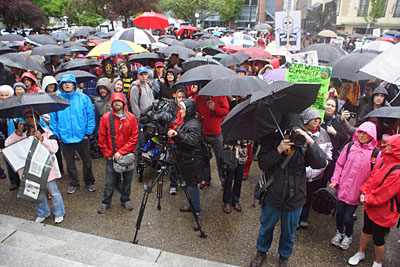 In a strong and unflinching voice, she started the gathered crowd going, raising the level of passion till the protesters matched her in full throated cry – hell no Monsanto, we don’t want your GMO.
In a strong and unflinching voice, she started the gathered crowd going, raising the level of passion till the protesters matched her in full throated cry – hell no Monsanto, we don’t want your GMO. At the end point of the march, at BC place, we finally got the mini-group picture – of the four musketeers that joined hands with the thousands in Vancouver and millions around the world, to bring down the evil empire. Thats pocket dynamo and march coordinator super volunteer, Laura (NoEnbridge) Yates, with Tony (citizen journalist) Mitra, Phil (leading GE free Surrey) Harrison and Tony (leading GE free Vancouver) Beck.
At the end point of the march, at BC place, we finally got the mini-group picture – of the four musketeers that joined hands with the thousands in Vancouver and millions around the world, to bring down the evil empire. Thats pocket dynamo and march coordinator super volunteer, Laura (NoEnbridge) Yates, with Tony (citizen journalist) Mitra, Phil (leading GE free Surrey) Harrison and Tony (leading GE free Vancouver) Beck.